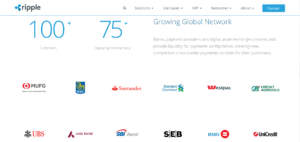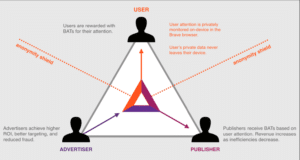Tired of Speculation? These Cryptocompanies Provide Working Platforms and Services
Taking a dive into the world of cryptocurrency can be an overwhelming experience.
More than 1,000 blockchain-supported cryptocurrencies circulating on 100+ online markets means that the crypto-pool is deep and wide. This dizzying array of options could leave a fledgling investor or crypto-enthusiast suffocated with market anxiety.
However, amidst this mass of speculation-driven ICOs, some healthy research can direct you towards promising companies with actual working products.
Cryptocurrencies are no longer a technological novelty for your stereotypical basement-dweller, and the following cryptocompanies are a testament to this.
Their platforms are fully functional and integrate blockchain into everyday services, giving the technology increased exposure to the public fold.
Ripple (XRP)
Founded in 2012, Ripple is a blockchain payment protocol that runs as a real-time gross settlement system. Don’t get too hung up on the jargon. Simply put, Ripple provides answers to problems that the international business community confronts, such as the need for currency exchange, lengthy transaction times, and transaction fees.
For example, if a company wants to transact business across borders, it can take anywhere from 3-5 days to relocate capital or issue a payment. If you couple that with high transaction fees and fiat exchange rates, moving mass amounts of funds from one country to another can be a painstaking process.
Enter Ripple.
Ripple’s payment protocol streamlines the transaction process for companies with its blockchain and currency (XRP). The blockchain provides real-time transactions through a decentralized, secure system, and XRP provides liquidity for the transferred funds.
Additionally, the protocol reduces transaction costs to a minuscule fee starting at .00001 XRP (fractions of fractions of a penny).
Ripple in Practice
Ripple’s platform, the Ripple Transaction Protocol, is seeing increased adoption by international financial institutions. Users interact with each other through gateways on ripple.net. From these gateways, they can interact with other members of the Ripple Transaction Protocol by sending, receiving, and exchanging funds in the forms of XRP and fiat currencies.
Ripple’s blockchain serves as a ledger for these transactions, publically storing the transaction data in the blocks that constitute the protocol.
The concept sounds revolutionary, and so far, Ripple is proving that it is. An impressive 100+ companies utilize Ripple for capital exchange, including many prominent banks like UBS, Santander, and UniCredit.
So far, Ripple has demonstrated that its real-world application has real-world value to the global financial and business realm, and its already widely-utilized protocol is likely to attract more users as the company gains momentum and exposure.
Siacoin (SC)
Don’t worry, this isn’t another attempt by a pop star to ride the cryptocurrency wave (looking at you, DJ Khaled). Incidentally, the pop singer Sia has nothing to do with Siacoin. Its inception dates back to the 2013 HackMIT competition. The company wants to harness the potential of the world’s unused storage with blockchain technology. Essentially, Siacoin wants to create a collaborative cloud storage platform through a network of individually managed datacenters.
These datacenters allow users to manage data through the blockchain. The storage hubs act as individual nodes that support the entire system, so instead of existing on one centralized server (e.g., Dropbox), the cloud exists through a decentralized network of user-run memory storage.
Using Sia
Unlike other cloud storage platforms, Sia does not operate from a domain name. Instead, the program can be downloaded from Sia’s website.
Once downloaded, users can upload a file onto the cloud to be hosted in one of the blockchain’s data centers. Alternatively, users can choose to host a data-center for payment in Siacoin. To ensure hosts don’t compromise or misuse personal data, smart contracts ensure that hosts are not paid unless they securely store the information. Sia’s platform also encrypts and makes all data redundant to further ensure data security.
The platform is currently active and, like Ripple, is geared more towards businesses than the average individual, but given time and technological growth, Sia could become a cheaper alternative to mainstream cloud services in the future.
Steem (SMT)
Steem is trying to alter how internet content is created, shared, incentivized, and even rewarded. The blockchain operates using what its creators call Proof of Brain. Unlike Proof of Work coins that circulate currency through mining output (e.g., Bitcoin), Steem is distributed by upvoting or liking content that community members generate.
When a post or comment is upvoted, the creator of that content receives a comparable amount of SMTs (or Smart Media Token, Steem’s currency). Yes, you read that correctly–you can be paid for your social media interactions.
So Where Does Steem Work?
Steem’s social media counterpart, Steemit, incorporates the currency into its platform. With it, users can engage with each other through a network of blog posts and comment sections, all the while earning SMT for the popularity of their contributions.
As of November 2017, Steemit has over 400,000 registered accounts and accrues 90,000+ daily posts. Much of the content is, unsurprisingly, cryptocurrency related at the moment, but mainstream adoption is leading to a greater diversity of content creation.
For instance, there are category tags for anything from sports and travel to memes and history, with top trending posts paying out anywhere between $30.00-$200.00. You know those conspiracy theories you share that no one listens to? Well, even those have value on Steemit, and we think that’s pretty neat.
Steem is ultimately trying to set a new standard for the social media platform, but only time will tell whether the internet community accepts a profit-driven approach to online interactions.
Basic Attention (BAT)
Much like Steem, Basic Attention is using individualized profit incentives to overhaul how we interact with online services. For BAT, though, the target is advertising, not social media.
The idea is to streamline advertising services to include viewers, publishers, and advertisers only, eliminating the need for middlemen in the process and reducing the potential for marketing fraud. Built on the Ethereum blockchain, the project is an open source, decentralized digital advertising platform fueled by the BAT token. Users on the platform will be rewarded in BAT for their attention and advertisement viewing, and publishers will receive BAT proportional to the popularity of their published advertisements.
Where Is this Implemented?
If you’re looking to be rewarded for guiltless consumerism, The Brave browser currently supports the Basic Attention platform. It features an in-browser wallet to store the BAT users earn on the interface by viewing ads. Ad-viewing, however, is completely optional, as the Brave browser will not display ads unless the user enables them.
The browser also includes a Brave Payments feature, allowing users to donate a portion of their BAT directly from their browser wallets to their favorite websites; in the future, Brave Payments may be used for services, products, subscriptions, and the like when websites implement the BAT payment function.
Brave also utilizes the Basic Attention Metric system to measure user satisfaction and attention. With this metric, Basic Attention is able to accurately gauge which advertisements garner the most views by assessing which advertisements each viewer privileges. This ensures that publishers receive accurate compensation for an ad’s popularity, and it also guarantees that advertisers get optimal exposure for their services by tracking and targeting user interests.
Ultimately, it’s a win-win for all involved: viewers get paid for exposure to ads they want to see, advertisers reach their target markets, and publishers don’t have to fret with fraudulent marketing undercutting their profits.
Right now, Brave is the only browser that accommodates Basic Attention’s platform, but as Basic Attention grows, its team hopes for more widespread adoption of its blockchain’s protocol. It is one of the few blockchain technologies that want to shake up digital advertising for the better by eliminating fraud, reducing the threat of malware, and providing a more accurate metric for measuring ad exposure and user interest.
Brave is the first tangible application of Basic Attention’s technology, but if it becomes popular with users, publishers, and advertisers, mainstream adoption could make BAT the new standard for online marketing.
Final Thoughts
Keep in mind that this is not an exhaustive list and some of these platforms, while active, still require further development. But, in general, these platforms have proven their feasibility and technological tangibility compared to other blockchain-powered companies whose technology is in its theoretical development.
It’s an exciting time for technology, as blockchain has made the creation of high-level solutions or optimizations of current solutions within reach for many people.
Be sure to educate yourself on industry trends and follow some of your favorite companies to keep up with their progress.
Never Miss Another Opportunity! Get hand selected news & info from our Crypto Experts so you can make educated, informed decisions that directly affect your crypto profits. Subscribe to CoinCentral free newsletter now.














